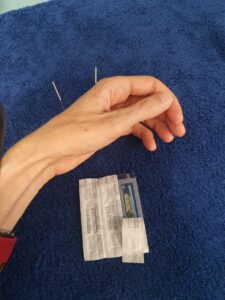Acupuncture has a history spanning thousands of years. Some of the earliest text recorded containing discussions of both Acupuncture and Chinese Herbal Medicine date as far back as 474 B.C.!
Acupuncture is simply the painless insertion of sterile, single use needles into the body to stimulate the bodies self-healing mechanism. Our understanding of how this works is evolving all the time.
But what is known is that Acupuncture releases pain killing endorphins in the brain, stimulates the nervous system and can even increase the production of white blood cells (the immune system).
Although Acupuncture has many clinical uses, it is probably best known for the treatment of pain, regardless of the cause.
In Australia, a trained Acupuncturist must undergo a minimum of 4 years full time study, including substantial training in Western medicine with subjects like Chemistry, Pharmacology, human Anatomy and Biology. Bachelor of Health Science trained Acupuncturists must complete that same level of science as an undergraduate medical student.
Acupuncture is a wholistic medicine, which means you are supposed to treat the WHOLE PERSON. For example, if a patient comes to my clinic complaining of shoulder pain, I treat them from a whole-body perspective. This means I still need to ask them about their sleep, stomach, bowel habits, headaches ect… as we treat the PERSON first and the CONDITION second, or at least I do.
Obviously, I need to try and get them results for the shoulder pain, which is the reason they came to my clinic to begin with. But pain is a symptom, not the cause. My job as an Acupuncturist is to identify the cause and treat that, not just apply a band-aid to reduce the pain for a short time.
Acupuncture is practised in many different ways, depending on where the practitioner has been trained and how they developed their practise.
I personally use a specific style of Acupuncture called ‘The Balance Method’ which involves understanding the interconnections of the body. This can be confusing for patients because I never insert needles anywhere near the location of their pain, and quite often use the opposite side of the pain! I practise this way because the results are far superior and the patient often feels immediate improvement in pain, which is not possible with local needling.
This is my 10th year of clinical practise, and I have only been using ‘The Balance Method’ for the last two years. Although it is a more advanced style of Acupuncture, the results can be spectacular, and it has revolutionized my clinical practise.
Pain is not the only complaint I see in clinic, and this style is highly effective for many health conditions. If you would like to know whether Acupuncture can assist your health complaint, please contact me at the clinic.
High quality herbal granules I use in my clinic. Herbs treat many conditions. Simply add boiling water, stir and make into tea, and drink. Simple!

An example of Acupuncture in the hand, sterile needles are single use. These two points called Ling Ku and Da Bai are powerful and have many applications in the clinic for pain relief and many other conditions.



